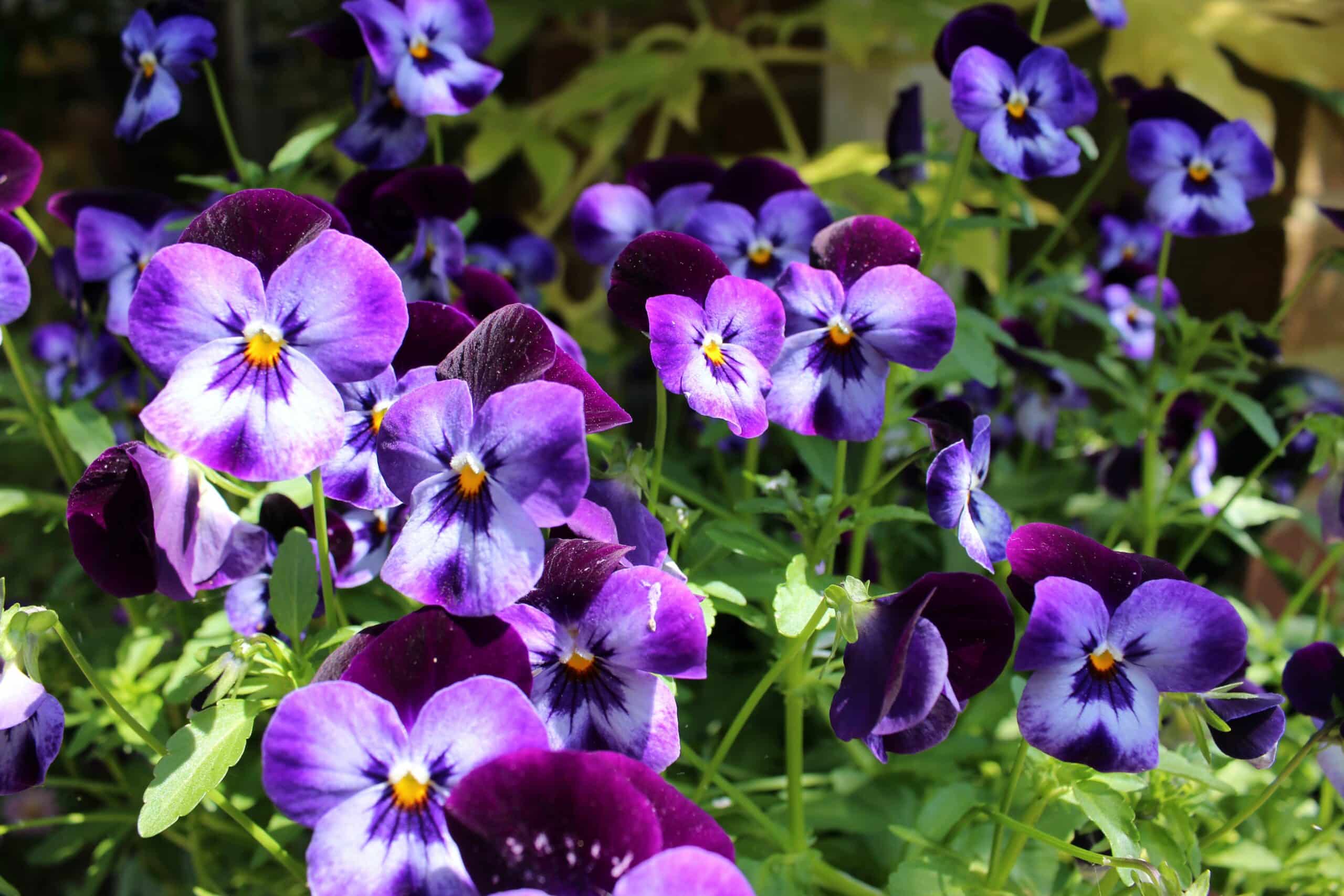Pansies are a perennial favorite for gardeners who enjoy bright and cheery blooms in cool weather. From vibrant violet to mellow yellow, these striking little flowers bring color and joy to any garden. Perfect for spring and fall planting, pansies are a great way to spruce up a garden, no matter the season. In this article, we’ll explore how to grow and care for pansies so you can enjoy their beauty all year round!
From planting to pruning, there is much to consider when growing pansies. Taking the right steps will ensure that your plants are healthy and happy throughout the entire season. Keep reading to discover helpful tips on how to get the most out of your pansy plants!
With proper care, you can expect your pansies to bloom again year after year. Whether you’re an experienced gardener or just starting out, it’s easy to learn how to grow and care for these beautiful flowers with minimal effort and maximum results. Read on as we provide everything you need to know about these lovely plants!
Overview Of Pansies
Pansies are a popular and versatile flower that can be planted in gardens all year round. They come in hundreds of varieties, offering gardeners a wide range of colors, sizes, and shapes to choose from. In fact, they’re so loved that they were named the 2019 National Flower by the National Garden Bureau.
Not only are pansies beautiful and easy to grow, but they also tolerate cold temperatures better than most flowers. With proper care and attention, these charming blooms will stay vibrant and colorful throughout the cooler months of autumn and spring.
To get started with growing your own pansies, you’ll need to select plants for your garden. It’s important to choose varieties suited for your climate zone, as well as ones that fit the size of your space. Additionally, consider the amount of sunlight available and how much maintenance you’re willing to provide. With this information in hand, you can make informed decisions about what type of pansy will work best in your garden!
Selecting Pansies For Your Garden
When it comes to selecting pansies for your garden, you have plenty of choices. From vibrant colors to unique shapes and sizes, there’s something for everyone. Not all pansies are created equal though – some may be better suited for your region or the type of soil you have in your garden. It’s important to do some research on the varieties that will thrive in your climate and soil before buying them so you can get the most out of your purchase.
Another factor to consider when selecting pansies is how much sun they receive. If you’re planting them in a shady area, look for varieties that are bred specifically for low light conditions. If they’ll be exposed to direct sunlight, opt for varieties that can handle more intense heat and UV rays. Additionally, make sure to check if there are any pests or diseases in your area which could affect the growth and health of your plants.
When shopping around, look closely at the quality of the pansies and how healthy they appear before committing to a purchase; this will ensure that you get strong plants that will grow well in your garden. Remember – healthy roots are essential for sustained success! With careful selection and proper care, you can enjoy beautiful blooms from spring through fall with pansies in your garden.
Where To Plant Pansies
Pansies are a beautiful flower that adds color and texture to any garden. In fact, according to a survey conducted by the National Gardening Association, 76% of people said pansies were their favorite flower for winter gardens! Planting pansies is an easy way to inject a burst of vibrant colors into your outdoor space.
When selecting where to plant pansies, it’s important to consider the climate and amount of sun in your area. Pansies prefer cold climates and partial shade; however, they can also tolerate full sun conditions if temperatures remain cool. If you live in a warm climate, you should choose a spot that gets morning sun and is shaded from the afternoon heat. Additionally, make sure the soil drains well so your pansies do not get waterlogged or rot.
When planting pansies, be sure to use quality soil amended with organic material such as compost or manure. This will help ensure that your flowers get adequate nutrients while also helping maintain good drainage in the soil. You can also mulch around your plants with shredded leaves or bark chips to help retain moisture and provide insulation during cold weather months. With proper care and attention, you’ll soon have healthy blooming pansies in your garden!
Soil Requirements For Pansies
Gardening is like a relationship: you have to give in order to get. When it comes to pansies, they need special soil requirements to truly thrive. Let’s take a look at the care and nourishment your pansy plants will need to stay beautiful and healthy.
The soil for your pansies should be well-draining, light, and rich in organic matter. Adding compost or peat moss can help achieve this ideal growing environment. You should also make sure that the pH level is slightly acidic—between 5.5 and 6.5 is best for pansies. If you’re not sure about the pH level of your soil, you can always buy a lite test kit from your local garden center and test it yourself!
Once you’ve set up their ideal home, don’t forget to water your pansies regularly! They’ll need about an inch of water each week during the growing season (or more if it’s particularly hot) so keep an eye out for signs of drought stress like wilting leaves or yellowing blooms. Taking good care of the soil will ensure that your pansies are able to absorb all the nutrients they need while keeping them hydrated enough to stay healthy and vibrant all season long!
Pansies may be considered cool-weather flowers, but with proper soil preparation and regular watering, they’ll bring some warmth into any garden space! Now that we know what kind of soil our pansies prefer let’s move on to understanding how much sunlight they need…
Sunlight Requirements For Pansies
The sun’s rays beaming down on a bed of pansies, their vibrant colors and delicate petals swaying in the gentle breeze – this is the sight that awaits if you provide the right sunlight requirements for pansies. When it comes to growing these beautiful blooms, here are three things to consider:
- Pansies need at least 6 hours of direct sunlight each day.
- Too much direct sunlight can damage the flowers, so choose a spot with some afternoon shade.
- In regions with hot summers, pansies should be grown in an area that receives morning sun and afternoon shade for optimal growth and flowering.
To ensure your pansies thrive, monitor how much light they receive throughout the season. If you notice their leaves becoming pale or discolored, move them to a location with more light or less heat to help them maintain their vibrancy and beauty. As you provide your pansies with just the right amount of sunshine, you’ll be rewarded with an eye-catching garden display all season long!
Watering Pansies
Watering pansies is an important part of growing them successfully. It’s best to water these delicate flowers deeply once a week. If the top inch or two of soil is dry, it’s time to give them a drink. Make sure not to overwater your pansies, as this can lead to root rot and other problems. To avoid this, wait until the soil is dry before watering again.
When you do water, make sure you are thorough so that all the roots receive moisture evenly. You can check by sticking your finger into the soil up to your second knuckle and feeling for dampness or using a moisture meter if you’re unsure. Keep in mind that during hotter months, pansies may need more frequent watering — at least twice a week — while they will require less during cooler times of year.
Pansies are sensitive plants and require special attention when it comes to their water needs. Have patience with them and be mindful of how often they need to be watered, and you’ll have a thriving garden full of these beautiful blooms in no time! Now that you know how often to water your pansies and why it’s important, let’s look at fertilizing them for optimal growth and health.
Fertilizing Pansies
Fertilizing pansies is like a final step to ensure their good health and well-being. Just as a nutritious meal can boost a person’s energy, just the right fertilizer can give your beloved pansies the nourishment they need to thrive and bring beauty to your garden.
The best time to fertilize your pansies is when the plants are actively growing, typically in early spring and again in late summer or early fall. A slow-release granular fertilizer is an excellent choice for pansies, as it provides the plants with steady nutrition over time. If you’re unsure which type of fertilizer to use, consult with your local nursery or gardening center for advice on what kind of product will be suitable for your climate and soil type.
When applying fertilizer, it’s important to be mindful of how much you use at once. Too much can burn delicate foliage, so keep it light and spread evenly around each plant’s root area. Finally, give your beds or containers a thorough watering after fertilizing to help the nutrients absorb into the soil and get delivered directly to their roots.
Deadheading Pansies
Deadheading is a vital part of pansy care and an essential task if you want cheerful blooms throughout the season. Interestingly, up to 90% of deadheading tasks can be done within 2 minutes or less. This simple task can make all the difference when it comes to encouraging more flowers to bloom!
Deadheading is easy enough to do, and simply involves removing any wilted or faded flowers from the plant. This encourages the plant to focus its energy on producing more blooms instead of wasting it on seed production. It also prevents your pansies from becoming overgrown with old flowers and detracting from their overall appearance in your garden.
While deadheading, be sure to remove any brown or yellow petals as these are signs that the flower has passed its prime. Also take care not to damage any buds that may be forming at the same time. With a little bit of effort and some regular maintenance, you’ll have plenty of happy pansies in your garden this summer! Now let’s move onto controlling pests and diseases for a healthy pansy garden.
Controlling Pests And Diseases
Pansies are a gardeners delight, like twinkling stars that bring charm and color to your outdoor spaces. But for those beautiful blooms to thrive, you must be diligent about pests and diseases. A few key steps can help keep your pansy beds in peak condition.
Controlling pests and diseases starts with proper cultural practices, such as avoiding overcrowding of plants and planting them in open areas where they can receive enough sunlight and air circulation. In addition, regularly inspect the plants for signs of insects or disease. If you spot anything suspicious, take immediate action to stop it from spreading. Prune off affected leaves or flowers, and dispose of them away from the garden. You may also consider using insecticidal soap or horticultural oil to remove any pests.
Finally, mix up a solution of water and vinegar in equal parts and spray it on the leaves to create an inhospitable environment for pests. This is especially important during periods when the weather is wet and warm — prime conditions for fungal infections — so be sure to check your plants often during this time. With these simple steps, you’ll have healthy pansies that will give you months of colorful beauty in return!
Winter Care For Pansies
When it comes to winter care for pansies, one can look no further than Anne’s garden in Maine. Every year, despite the harsh winters, her pansies are full and vibrant with life. How does she do it? By taking extra care with her winter pansy care routine.
Anne makes sure to mulch the area around her plants with a few inches of compost or leaves to insulate them from the cold. Additionally, she provides any necessary protection against wind or snowfall by covering her plants with burlap or other fabric when needed. During extreme cold snaps, Anne will even bring some of her potted pansies indoors where they can still get plenty of sunlight.
Finally, Anne will also water her plants regularly throughout the winter months to keep them hydrated as much as possible. If a hard freeze is expected, she’ll reduce watering so that there won’t be too much moisture in the soil that could cause damage if it freezes solid. With this comprehensive winter care routine, Anne’s pansies are able to thrive and put on a colorful show every spring!
By following these tips for winter care, you too can ensure your pansies stay healthy and beautiful year-round – and be ready for propagation come springtime!
Propagating Pansies
Propagating pansies is a great way to ensure that your flower garden stays full of vibrant and colorful blooms year-round. It’s relatively easy to do, too, so even novice gardeners can experience success. Here’s what you need to know about propagating pansies.
You can propagate pansies either by dividing the existing roots or through seed propagation. When it comes to dividing, it’s best to wait until the flowering season is over and then dig up the clump of plants from the soil. Carefully divide them into smaller clumps, discarding any weak or damaged plants. Replant each of the new clumps in well-draining soil and provide plenty of light for optimal growth and development.
When it comes to seed propagation, plant your seeds in a light mix of soil during cold weather months such as late winter or early spring. Keep the soil moist but not soggy and be sure not to let it dry out completely as this may damage your new plants. With patience and proper care, you should have a thriving bed of pansies within several weeks!
Now that you know how to propagate pansies, you’re ready to combine them with other flowers for a colorful display in your garden.
Combining Pansies With Other Flowers
Combining pansies with other flowers is truly a sight to behold! There is nothing quite so spectacular as the vibrant colors and delicate petals of pansies, intermingled with other blooms to create a mesmerizing landscape. From dramatic bold colors to subtle pastels, this combination will surely impress any onlooker.
When considering which flowers look best with pansies, it is important to choose ones that have similar sun and soil requirements. Flowers like impatiens, violas, snapdragons, and dianthus are all good choices because they can thrive in the same environment as pansies. Planting them in clusters or alternating colors creates a stunning effect that draws attention wherever you place it.
To create an even more eye-catching display, consider adding foliage plants like sweet woodruff or hosta. These add texture and dimension that enhances the overall beauty of your garden design. With the right selection of complementary plants and careful placement, your garden can be transformed into a breathtaking oasis!
Drying Pansies
“A stitch in time saves nine,” and that is certainly true when it comes to preserving your beautiful pansies. Drying pansies is an easy way to enjoy their beauty for many months, even throughout the winter. Here are a few tips for drying pansies:
- Gather the flowers in the morning after the dew has evaporated:
- Choose blooms that are just beginning to wilt but still have good color.
- Cut stems at an angle with a sharp knife or scissors.
- Remove any foliage that would be below the water line in the vase or container you will use for drying.
- Prepare the flowers before air-drying:
- Place them upside down in shallow trays of silica gel, which will draw moisture away from the petals.
- Alternatively, hang them upside down in a warm and dry place like an attic or garage.
- After they are dried, condition them by gently brushing away excess silica gel or dust particles with a soft brush and store in airtight containers in a cool and dark place until you’re ready to use them again!
The process of drying pansies isn’t complicated but it does require some patience as it can take up to two weeks for the flowers to fully dry out. Once dried, you’ll have a stunning reminder of springtime’s beauty to enjoy year-round – perfect for crafting and decorating!
Using Pansies In Crafts And Decorations
When it comes to decorating for any season, pansies are the perfect choice! Their bright and vibrant colors can bring a space to life, making them ideal for crafting and decorations. From wreaths to centerpieces, there’s no end to the creative possibilities when working with these beautiful blossoms. Here’s a look at how you can use pansies in your next craft project.
If you’re looking for a way to add some color to your walls, why not try using dried pansies? With just a few simple steps, you can turn pansy petals into delightful designs that are sure to catch people’s eyes. Start by snipping off the flower heads and gently pulling apart the petals. Then lay them out on wax paper before placing them in an oven set at low heat. Once they’re dry, you can arrange them in whatever pattern or design you choose.
For floral arrangements, fresh or dried pansies make excellent choices due to their long-lasting blooms and vibrant colors. Whether used as an accent piece or as the main focus of a centerpiece, these delicate flowers will add beauty and charm. For added texture, mix in other seasonal foliage like ferns or evergreens—you’ll be surprised at how stunningly natural the arrangement looks! With these tips in mind, let your creativity run wild and create something beautiful with your favorite winter blooms! Transitioning from crafting with pansies to troubleshooting problems with them is the next step in learning about their care and maintenance!
Troubleshooting Pansy Problems
Troubleshooting pansy problems can be tricky. After all, they are a cool weather favorite and require special care. But it’s worth the effort to keep these beautiful flowers healthy and blooming in your garden. From pests to diseases, let’s take a look at some common issues and how to fix them.
Pests such as aphids and slugs can cause damage to pansies. Fortunately, there are solutions for both of these problems: for aphids, you can use an insecticidal soap spray; for slugs, try using beer traps around the plants. If possible, identify the problem first before proceeding with treatment options.
Finally, disease can also be a concern when growing pansies. Be sure to check your plants regularly for any signs of wilting or discoloration which may indicate fungal or bacterial diseases such as powdery mildew or botrytis blight. If caught early enough, either of these diseases can often be treated with fungicides or other non-toxic treatments like neem oil or baking soda sprays.
No matter what issue you’re dealing with—pest infestations or disease—proper care is key to keeping your pansies healthy and vibrant throughout the season. Knowing what problems to look out for and having a plan of action ready will help ensure that your garden stays beautiful all year round!
Frequently Asked Questions
How Soon After Planting Will Pansies Begin To Bloom?
Pansies are a cool-weather favorite that can bring vibrant color to your garden, but how soon after planting will you start to see the blooms? Depending on the type of pansy and your local climate, you can expect to see flowers in as little as six weeks.
It’s important to give your pansies plenty of water and sunshine when planting them for the best results. Soil should also be prepared with compost or manure for optimal growth. Once planted, pansies should be watered frequently and kept moist until they’ve established themselves in the ground. The soil should also be mulched to retain moisture and keep weeds at bay.
With proper care, you’ll likely have blooms in no time! Pansies are hearty plants that thrive in cooler temperatures, so you don’t need to worry too much about leaving them out during cold snaps. For an added bonus, deadheading spent flowers can encourage new buds to open up and produce more blooms throughout the season. With just a bit of effort and some patience, you’ll be able enjoy these cheerful flowers all season long!
How Do You Keep Pansies From Spreading Too Much?
Taking care of your pansy plants doesn’t have to be a difficult task. Although they can spread quite quickly, there are several easy steps you can take to keep them in check.
First, it’s important to understand that pansies are cool-weather plants and will generally spread more rapidly in the warmer months. To prevent them from becoming invasive, you should consider planting them in an area that gets partial shade or morning sun and is protected from strong winds.
There are also some practical measures you can take to stop your pansies from spreading too much: • Water the plants deeply but infrequently – this encourages deep root growth which helps contain the plant’s size. • Prune regularly – this will help control their shape and size, as well as encourage bushier growth. • Fertilize every two weeks – this will help keep your plant healthy and deliver essential nutrients for its growth. • Divide established plants – dividing pansies into smaller sections helps reduce overcrowding, which can lead to rampant spreading. • Use mulch – applying a layer of mulch around the base of the plant not only helps retain moisture but also prevents weeds from competing with your pansies for resources.
By taking these simple steps, you can ensure that your pansy plants remain healthy and happy without taking over your garden! With the right care and attention, you’ll be able to enjoy these beautiful flowers for many years to come.
What Are The Best Temperatures For Growing Pansies?
Growing pansies is a great way to bring a splash of color to your garden. But if you want them to thrive, you need to understand the best temperatures for their growth. Let’s take a look at what temperatures are best for growing pansies and how to get the most out of them:
First, it’s important to know that pansies prefer cooler temperatures, with an optimum range between 45-65 degrees Fahrenheit. To ensure your plants have enough water, keep the soil evenly moist throughout the growing season. If you live in an area that has hot summers, you may want to consider planting them in late summer or early fall when temperatures start to cool off.
In addition, here are four tips for keeping your pansy plants happy and healthy:
- Provide plenty of sunshine – at least five hours per day.
- Feed your plants regularly with a balanced fertilizer every two weeks during the growing season.
- Deadhead spent flowers regularly so new blossoms can grow in their place.
- Cover plants with a light mulch over winter months to protect from frost damage.
With these simple tips in mind, you’ll be well on your way to enjoying beautiful blooms from your pansy garden all season long!
What Is The Best Way To Protect Pansies From Extreme Temperatures?
When deciding how to protect your pansies from extreme temperatures, its important to understand the best way to help them flourish. Pansies are known for their vibrant colors and delicate petals, making them a popular cool weather flower. To ensure that your pansies thrive in all types of weather, here are four key points to keep in mind:
First and foremost, it’s important to know the ideal temperature range for growing pansies. They do best with temperatures between 40-75 degrees Fahrenheit, so if it’s too hot or too cold outside they may not survive. In addition, you should avoid exposing them to sudden changes in temperature. If you live in an area with harsh winters, consider planting your pansies in a pot and bringing them indoors during the coldest months of the year.
Next, provide adequate shelter for your plants by placing them in a sheltered location such as near a fence or wall that will block wind and intense sun exposure. Consider adding mulch around the plant’s base which will help keep moisture levels consistent and insulate against any drastic changes in temperature. Furthermore, make sure that when watering your pansies you use lukewarm water so as not to shock their delicate roots.
Finally, be mindful of frost protection when caring for your pansies; if frost is forecasted cover your plants with plastic sheets or blankets to shield from freezing temperatures during the night. By following these steps you can enjoy beautiful blooms year-round no matter what kind of climate you live in!
Is There A Certain Type Of Pansy That Is More Resistant To Pests?
When it comes to growing and caring for pansies, many gardeners worry about pests. Thankfully, there are certain types of pansy that are more resistant to pests, giving you peace of mind when growing them in your garden. In this article, we’ll explore which types of pansy offer the best resistance to pests and what other steps you can take to protect them from unwanted visitors.
Pansies come in all shapes and sizes, so it’s important to find the right type for your garden. Look for varieties such as ‘Marmalade’, ‘Pacific Giants’, and ‘Universal’—these have been bred especially for their resistance to common pests like aphids and slugs. Additionally, they are also less likely to be affected by fungal diseases than other varieties.
To ensure your pansies remain healthy and pest-free, consider planting them in raised beds or containers rather than directly in the ground. This will help keep the soil moist and prevent slugs from gaining access to them. Additionally, be sure to water only at the base of the plant—not on its leaves—to avoid creating an inviting environment for pests.
By taking these precautions and choosing varieties with natural pest-resistance properties, you can rest assured that your pansy plants will thrive even during extreme temperatures. With just a little bit of extra care and attention, you should have beautiful blooms throughout the season!
Conclusion
The pansy is a beautiful flower that can bring delight to any garden. It’s a cool weather favorite, and if you care for it properly, it can bloom in your garden all season long. With proper soil preparation, planting, and care, you can have a bed of pansies with bright colors to fill your garden with beauty and life.
Just like the pansy needs proper care in order to thrive, so too do we need proper care in order to thrive as individuals. We need love and nourishment just as the pansy needs sun and water. We must also protect ourselves from extreme temperatures – both literal and metaphorical – so that we don’t wither away. And most importantly we must stay resilient against pests – whether they be physical or emotional – in order to remain strong and healthy.
By taking lessons from the pansy, we can learn how to best take care of ourselves in order to live our best lives. Just like the pansy brings beauty and life into our gardens, caring for ourselves will bring light into our own lives and help us flourish every season.





























